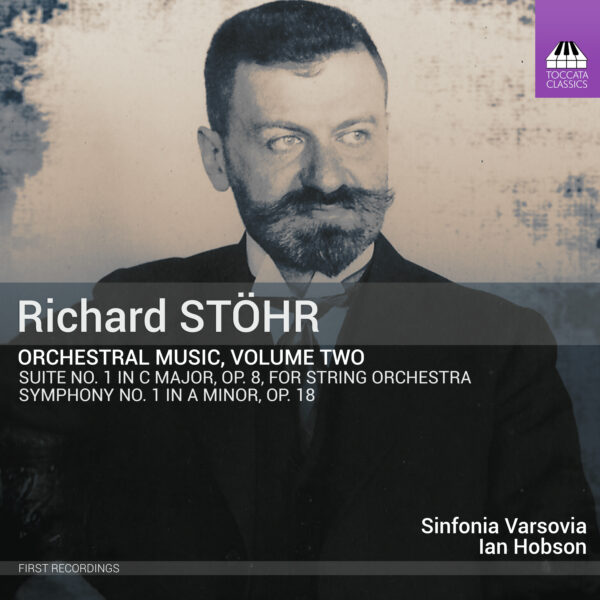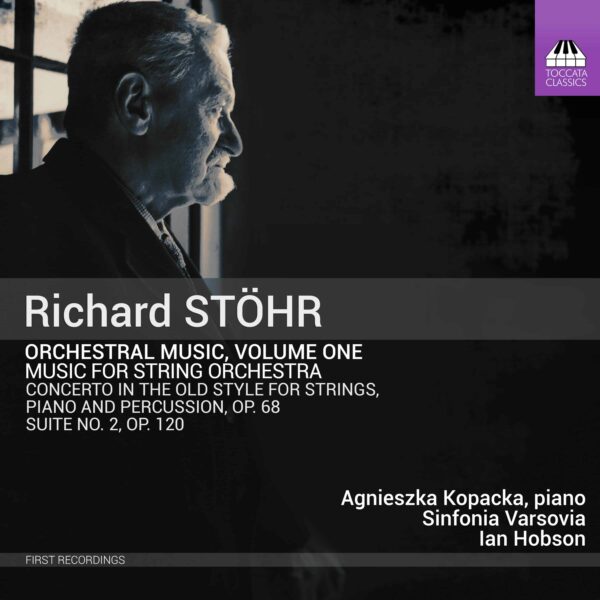Richard Stöhr: Orchestral Music, Volume Two
This second volume of the orchestral music of the Austro- American composer Richard Stöhr (1874–1967) reveals further marvels: the first of his two suites for string orchestra encases a moving slow movement between a charming prelude and an elegant fugue; and the four imposing spans of the expansive First Symphony offer grandeur and heartfelt profundity – as well as irresistibly catchy tunes that will set the foot tapping. Stöhr writes in a musical language somewhere between Bruckner, Mahler and his exact Viennese contemporary Franz Schmidt – but it is a voice increasingly readily recognised as his own.
Sinfonia Varsovia
Piotr Wilczyński, organ
Ian Hobson
Listen To This Recording:
Suite No. 1 in C Major, Op. 8 for string Orchestra (publ. 1909) (18:42)
- I. Präludium: Presto (4:16)
- II. Andante (9:35)
- III. Fuge: Allegro grazioso (4:51)
Symphony No. 1 in A Minor, Op. 18 (1909) (49:20)
- I. Andante maestoso (15:32)
- II. Scherzo: Allegro commodo – Quasi allegretto (12:56)
- III. Andante religioso (8:16)
- IV. Finale: Vivacissimo (12:36)
First Recordings


Frank Lehman :
‘Gotta add this to my list of favorite newly discovered symphonies of 2023 […]
If nothing else, the liner notes by William Melton are incredible, some of the deepest and I assume completely original archival and analytical research I’ve ever read in this format — 68 footnotes! One of the many reasons physical media is INDISPENSIBLE.
The music is terrific too, especially the slow movement, which is like a personal gift to me, who’s been hunting for manifestly Bruckner-inspired adagios by Jewish composers.’
— Frank Lehman
Fanfare Magazine :
[my respect for the conductor and the piani in the recording] is only augmented by the performances heard herein. […]
From the first notes of [symphony No,1’s] busy opening movement, I found the work to be an unalloyed delight as it careens through a number of tonal areas in sprightly moto perpetuo fashion. The Andante movement that follows is overflowing with lush harmonies that are drawn out by Hobson and his string orchestra to create an opulent sound (one of the richest I’ve ever heard) that is enhanced by the wonderful acoustics of the Lutosławski Concert Hall in Warsaw. This slow movement extends to almost 10 minutes, but the listener’s interest never flags due to the composer’s rich harmonies and the performers’ splendid presentation of the piece. No less captivating is the fugally forged closing movement, which is performed in such dance-like fashion that I, as a committed chair-warmer, desired to get up and traipse around my office […]. Hobson’s accelerando at the end of the work also added to the excitement. […]
I absolutely loved [this album] from beginning to end, both in music and performance. […]Richard Stöhr is as important composer as any who has been rescued from obscurity by Toccata. Anyone enamored of the Romantic symphonic tradition will want to acquire [this album. […] This set will be a strong contender for my next Want List.’
—David DeBoor Canfield, Fanfare Magazine, April 2025
WTJU :
‘Both [works] are beautifully crafted compositions. […]
Stöhr was an effective orchestrator. His use of brass is particularly effective. […]
The Sinfonia Varsovia is in top form here. Under Ian Hobson’s direction, they’ve captured the Viennese character of Stöhr’s music.
Stöhr may not have been a modern composer, but he was true to himself. These are works of great originality that can still speak to audiences today.’
—Ralph Graves, WTJU
Classical Music Sentinel :
‘These are all first recordings, all worth the attention of classical music enthusiasts eager to hear hitherto unavailable material.’
—Jean-Yves Duperron, Classical Music Sentinel